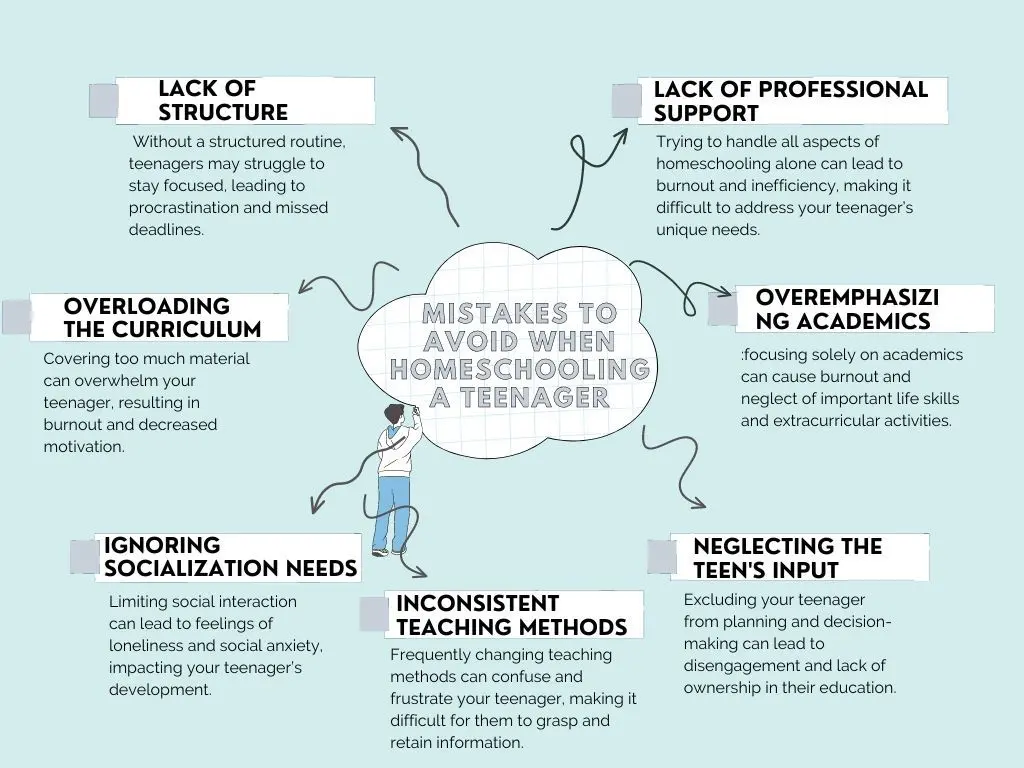Avoid common pitfalls when homeschooling a teenager. Learn 7 key mistakes to avoid and create a productive learning environment. Discover practical tips now!

Homeschooling a teenager can be a rewarding but challenging journey. As the homeschooling movement gains momentum in the United States, it’s essential to understand the common pitfalls that can hinder a teenager’s educational experience.
According to the Research, over 3.1 million students were homeschooled in 20201-2022, and this number continues to grow. However, without proper guidance, homeschooling a teenager can lead to mistakes that affect their academic performance and emotional well-being.
This guide aims to help parents navigate the complexities of homeschooling a teenager by highlighting seven critical mistakes to avoid.
Here are the Mistakes to Avoid When Homeschooling a Teenager.

Mistake 1: Lack of Structure
One of the biggest mistakes when homeschooling a teenager is failing to establish a structured routine. Teenagers thrive on consistency and predictability, which help them manage their time and responsibilities effectively. Without a structured environment, they may struggle to stay focused, leading to procrastination and missed deadlines.
Consequences of Not Having a Structured Routine
A lack of structure can result in poor academic performance, increased stress, and decreased motivation. Teenagers without a clear schedule may find it challenging to balance their studies with extracurricular activities and personal interests. This can result in a disorganized and unproductive learning environment.
To illustrate, consider a family homeschooling a teenager who initially tried a relaxed, unscheduled approach. The teenager found it difficult to keep track of assignments and often missed deadlines, leading to frustration for both the student and the parents. Once they implemented a structured routine, the teenager’s performance and overall mood improved significantly.
Tips for Creating a Balanced Schedule
To avoid this mistake, create a daily schedule that includes designated times for each subject, breaks, and leisure activities. Use tools like planners or digital calendars to help your teenager manage their time. Encourage them to stick to the schedule consistently to develop good habits and maintain a sense of order.
Mistake 2: Overloading the Curriculum
Parents often feel the need to cover an extensive curriculum to ensure their teenager receives a well-rounded education. However, this can lead to an overwhelming and stressful experience for both the parent and the teenager.
Impacts on the Teenager’s Motivation and Mental Health
Overloading the curriculum can result in burnout, decreased motivation, and mental health issues such as anxiety and depression. Teenagers may feel pressured to keep up with the pace, leading to frustration and disengagement from learning.
For instance, a parent homeschooling a teenager might decide to include advanced courses in science, math, literature, and foreign languages all at once. The teenager, feeling overwhelmed, might start to dread schoolwork and struggle to maintain interest in any subject.
Strategies for Streamlining and Focusing on Essential Subjects
Focus on core subjects that are essential for your teenager’s academic growth. Prioritize quality over quantity by selecting materials that align with their interests and future goals. Consider integrating cross-disciplinary projects that combine multiple subjects, making learning more engaging and relevant.
Mistake 3: Ignoring Socialization Needs
Socialization is a critical aspect of a teenager’s development. While homeschooling a teenager offers a personalized learning experience, it can sometimes limit opportunities for social interaction.
Risks of Social Isolation while homeschooling a teenager
Lack of socialization can lead to feelings of loneliness, social anxiety, and difficulty in developing essential life skills. It’s important to recognize that teenagers need to interact with peers to build relationships, learn social norms, and develop communication skills.
For example, a teenager who is homeschooled without regular social interactions may struggle to work in team settings or feel isolated from their peers. Integrating social activities can help mitigate these issues.
Suggestions for Ensuring Adequate Social Opportunities
To avoid this mistake, involve your teenager in community activities, sports teams, clubs, or volunteer work. Encourage participation in homeschooling co-ops where they can meet and collaborate with other homeschooled students. Online forums and virtual study groups can also provide valuable social interaction.
Mistake 4: Inconsistent Teaching Methods
Inconsistent teaching methods can confuse and frustrate teenagers, making it difficult for them to grasp and retain information. Consistency in teaching styles and expectations is crucial for effective learning.
Importance of Sticking to an Effective Teaching Method
Identify a teaching method that works best for your teenager and stick to it. Whether it’s project-based learning, classical education, or unschooling, consistency helps build a stable learning environment.
For example, if a family initially starts with a classical education approach but frequently switches to other methods like unschooling or Montessori without a clear plan, the teenager might struggle to adapt and keep up with varying expectations.
Examples of Consistent Teaching Practices
Implement regular assessments to track progress and provide feedback. Use the same format for assignments and tests to create a familiar routine. Adjust your teaching approach based on your teenager’s feedback and learning style to maintain consistency.
Mistake 5: Neglecting the Teen’s Input
Involving your teenager in the planning and decision-making process is essential for their engagement and motivation. When they feel heard and valued, they are more likely to take ownership of their education.
Benefits of Considering the Teen’s Interests and Preferences
Incorporating your teenager’s interests and preferences into the curriculum can make learning more enjoyable and relevant. This personalized approach fosters a love for learning and encourages them to pursue their passions.
For instance, a teenager interested in environmental science might be more engaged if their curriculum includes projects related to sustainability and conservation, rather than a generic science syllabus.
Tips for Involving Your Teenager
Have regular discussions with your teenager about their goals, interests, and feedback on the homeschooling experience. Allow them to choose some of their subjects or projects. Empower them to set their own academic and personal development goals.
Mistake 6: Overemphasizing Academics
While academics are important, overemphasizing them can lead to burnout and neglect of other crucial life skills. Teenagers need a balanced education that includes physical activities, creative pursuits, and practical life skills.
Potential Burnout from Academic Overload
Focusing solely on academics can result in stress, fatigue, and a lack of motivation. Teenagers may miss out on opportunities to develop skills that are equally important for their overall growth and future success.
For instance, a parent homeschooling a teenager might insist on strict academic schedules without allowing time for hobbies or physical activities. This can lead to frustration and a lack of enthusiasm for learning.
Ideas for Integrating Life Skills and Extracurricular Activities
Encourage your teenager to participate in activities like sports, music, art, cooking, and financial literacy. These activities help develop well-rounded individuals who can thrive in various aspects of life. Balance academic work with breaks and leisure activities to maintain a healthy lifestyle.
Mistake 7: Lack of Professional Support
Homeschooling a teenager can be challenging, and seeking help from educational professionals can provide valuable support and resources. Professionals can offer guidance on curriculum choices, teaching strategies, and addressing specific learning needs.
Consequences of Trying to Do Everything Alone
Trying to handle all aspects of homeschooling alone can lead to burnout and inefficiency. Without professional support, parents may struggle to provide a comprehensive education and address their teenager’s unique needs.
For example, parents homeschooling a teenager with learning disabilities might find it particularly beneficial to work with a specialized tutor or educational consultant to develop effective teaching strategies.
Resources for Professional Support and Advice
Utilize resources such as online courses, tutoring services, and educational consultants. Join homeschooling associations and attend workshops to stay informed and connected with other homeschooling families. Accessing professional support can enhance the homeschooling experience for both the parent and the teenager.
Conclusion
In conclusion, homeschooling a teenager requires careful planning, structure, and support to avoid common pitfalls. By understanding and addressing these seven mistakes—lack of structure, overloading the curriculum, ignoring socialization needs, inconsistent teaching methods, neglecting the teen’s input, overemphasizing academics, and lack of professional support—you can create a more effective and enjoyable homeschooling experience for your teenager.
Remember, flexibility and adaptation are key to successful homeschooling a teenager. If you have any questions or want to share your experiences, feel free to leave a comment below. Your insights can provide valuable support and encouragement to other parents navigating the homeschooling journey.
You may also be interested in : The 7 Homeschool Types: Which One Fits Your Child?